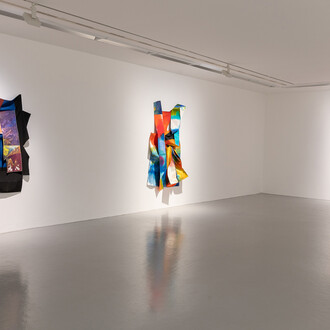Kerlin Gallery is pleased to present Pictures of you, guest curated by Miles Thurlow (Co-founder of Workplace).
The exhibition brings together 16 international and multigenerational artists, whose images, objects and actions evoke specific, often fleeting, moments whilst simultaneously revealing incisive reflections on time, memory and social structures.
Hannah Perry’s large-scale installation Rage fluids weaves through Pictures of you both physically and sonically, with huge sheets of curved metal and car wrap activated by the rumbling sound and vibrational energy of car stereo subwoofers. Similarly influenced by the industrial context of the North of England, Simeon Barclay references his father’s work as a tailor and childhood memories of playing dress-up in Pop pose, rupturing the fashion industry’s veneer of cool. Ryan Gander presents iconic modernist chairs – Gerrit Rietveld’s crate chair, Marcel Breuer’s Wassily B3 – overturned and covered in a marble ‘snow’, teasing out a web of issues around class, aspiration, manufacturing, and taste.
Drawing upon a rich archive of anonymous analogue photographs, Laura Lancaster transforms deeply personal memories into shimmering, impressionistic images that transcend their source material and tap into a broader collective memory. Eve Ackroyd’s small, intimate paintings explore the interpersonal dynamics of familial relationships and friendships, as well as her interiority and reflections on quotidian life. Sooim Jeong’s exuberant, expressive paintings capture heightened moments of anxiety and melodrama. Upturned legs in pond suggest a disastrous event, but light handling of paint and a pastel palette give the subject a lightness of touch and disarming gentleness.
James Cabaniuk’s tactile paintings give abstract forms to queer erotic encounters. Bodily fluids and bodily contact are insinuated through glittering, polychromatic surfaces, sprayed and hand-smeared paint, and distorted, suggestive forms. William McKeown’s paintings were guided by a belief in the primacy of feeling. Taking on the guise of objective minimalism and the monochrome, he presented us with so much more: nature as something real, tangible, all around us, to be touched and felt. Nan Goldin captures her friend and collaborator, the Irish artist/filmmaker Vivienne Dick, in a moment of cosmic wonder on an isolated beach, then turns the lens outwards to a lavender-infused, psychedelic vision of the Donegal coast. Merlin James’s paintings depict vernacular architecture, riverside views, post-industrial landscapes and moments of intimacy. His paintings of isolated buildings invited us to ruminate on distance and connection.
Hollis Frampton’s 1969 video piece Lemon gives a close study of a single citrus fruit, its devotional gaze drawing out the fruit’s bodily and sculptural qualities, and transforming a humble everyday object into something meditative and profound. Ki Yoong’s small-scale, intimate portraits have the feel of a small shrine or devotional object. Closely cropped to frame their subjects’ faces, each work captures a vulnerability and sense of deep connection between artist and sitter. Samuel Laurence Cunnane’s photographs deromanticise the popularly sentimental and yet their sensitivity to light, framing and texture give them a cinematic quality. Responding to the increasingly dematerialised nature of contemporary image making, Cunnane remains connected to the physicality of the production process, printing his photographs by hand in a darkroom.
Rachel Lancaster’s luminous paintings give cinematic depictions of mostly female subjects, building colour and depth using meticulous Renaissance techniques. Robin Megannity painstakingly creates digital environments using 3D graphics software, which then become the source material for his otherworldly paintings. Referencing Northern European still life paintings and using traditional techniques, they nevertheless include the glitches, ruptures and defamiliarised atmosphere of their digital origins. Wang Pei treats the eternally-intriguing subject of the human form is treated with delicacy and attentiveness. Using casein tempera, an ancient form of paint derived from milk, his paintings offer a deliberate ‘slowing down’ of image-making.
















